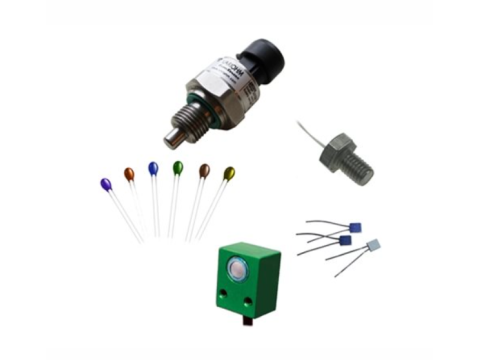A temperature sensor is a device that converts thermal energy (heat) into an electrical output signal. Note that while we commonly say “measure temperature,” the sensor itself only creates a change in current or voltage reflecting heat changes; an external instrument then interprets that electrical change as degrees on a scale. By selecting a suitable sensor—thermocouple, semiconductor, thermistor, or non-contact pyrometer—engineers and technicians can monitor processes accurately across a wide temperature range. Below, we discuss the working principles, advantages, and typical applications of these sensor types.
1. Thermoelectric Temperature Sensors (Thermocouples)
1.1 How They Work
A thermocouple consists of two wires made from dissimilar metals welded at a junction. This “hot junction” is placed where temperature must be measured, while the other ends (“cold junction”) remain at a reference temperature. The resulting voltage difference between the two junctions depends on the temperature difference, following the Seebeck effect.
1.2 Key Points
- Wide Temperature Range: Certain thermocouple types operate from sub-zero to extremely high temperatures.
- Need a Reference Temperature: The cold junction temperature must be known or compensated.
- Accuracy & Calibration: Achieving high accuracy often requires individualized calibration and stable reference compensation.
- Benefits: Simple, robust, and relatively inexpensive. Can withstand harsh environments and broad temperature spans.
1.3 Typical Applications
- Industrial Furnaces/Reactors: Where high heat tolerance is critical.
- Heaters, Ovens, and Kilns: For process monitoring and control.
- Gas Boilers and Cooktops: Over-temperature protection and temperature regulation.
2. Semiconductor Temperature Sensors
2.1 Operating Principle
Semiconductor-based sensors rely on the known dependency of a p-n junction voltage drop on temperature. With a controlled current passing through a diode or transistor junction, the voltage changes fairly linearly as temperature varies.
2.2 Advantages
- Integrated Electronics: Can incorporate analog-to-digital converters (ADC) for direct digital output.
- Simplicity: Provide near-linear output, reducing signal conditioning needs.
- Good Accuracy & Cost-Effective: Ideal for moderate temperature ranges, typically up to around 150°C (302°F).
2.3 Common Uses
- Consumer Electronics: Smart thermostats, CPU and GPU thermal monitoring, mobile devices.
- Smart Home Systems: Remote HVAC monitoring in “intelligent” thermostats.
- Low-Power IoT Devices: Where integrated digital interfaces like I²C or SPI are advantageous.
3. Thermoresistive Sensors (Thermistors)
3.1 Principles and Types
A thermistor changes its electrical resistance in response to temperature. Two main types exist:
- NTC (Negative Temperature Coefficient): Resistance decreases with rising temperature.
- PTC (Positive Temperature Coefficient): Resistance increases with rising temperature.
3.2 Characteristics
- Wide Range of Operating Temperatures: Divided into low, medium, and high temperature subsets.
- Key Specs: Nominal resistance (often specified at 25°C), maximum current or power, temperature coefficient of resistance.
- Calibration/Plot: Typically, a curve or chart depicts resistance vs. temperature.
3.3 Applications
- Industrial & Home Appliances: Temperature regulation in refrigerators, air conditioners, or water heaters.
- Overcurrent Protection: PTC thermistors can limit inrush currents for motors or other electronics.
- Simple Probes: Quick, cost-effective sensors for automotive or consumer product temperature readouts.
4. Non-Contact Pyrometric Sensors
4.1 Infrared Pyrometers
Infrared pyrometers measure an object’s IR emission without contact, computing temperature from the intensity of specific wavelengths. This approach is crucial where direct probes are impractical, such as very high-temperature processes or rotating machinery.
4.2 Typical Uses
- Industrial Monitoring: Checking surface temperatures of metals, glass, or ceramics at extreme heat.
- Medical and Consumer Devices: IR thermometers for body temperature checks.
- Infrared Imaging: Thermographic cameras for identifying heat leaks in buildings or hotspots in equipment.
5. Overview of Pros and Cons
5.1 Thermocouples
- Pros:
- Extremes of temperature
- Robust and relatively affordable
- Cons:
- Requires reference junction compensation
- Medium accuracy, typically 1–2°C standard error
5.2 Semiconductor Sensors
- Pros:
- Easy-to-use linear output, integrated ADC
- Ideal for digital and low-power circuits
- Cons:
- Limited temperature range (usually <150°C)
- Susceptible to supply voltage fluctuations
5.3 Thermistors
- Pros:
- High sensitivity around a narrow range
- Cost-effective for many consumer or industrial tasks
- Cons:
- Non-linear characteristic requiring compensation or look-up tables
- Physical fragility in some designs
5.4 Pyrometers (Non-Contact)
- Pros:
- No physical contact needed—essential for moving or very hot objects
- Rapid response
- Cons:
- Impacted by surface emissivity, reflection, or environmental factors
- Often more expensive
6. Conclusion
Whether you’re measuring the temperature of a blast furnace, an office environment, or a critical semiconductor component, temperature sensors play an essential role in modern process monitoring and automation. Each sensor type—thermocouple, semiconductor, thermistor, or non-contact—offers unique benefits and limitations:
- Thermocouples: Widest temperature range, robust in extreme conditions.
- Semiconductors: Straightforward digital interfacing, ideal for moderate ranges.
- Thermistors: High sensitivity and cost-effectiveness in specific temperature windows.
- Pyrometers: Essential for non-contact and extremely high temperatures.
Selecting the best sensor depends on factors like operating range, required accuracy, cost, and the environment. For detailed guidance in specifying, installing, or calibrating temperature sensors, safsale.com provides expert resources to optimize your system’s performance and reliability.

